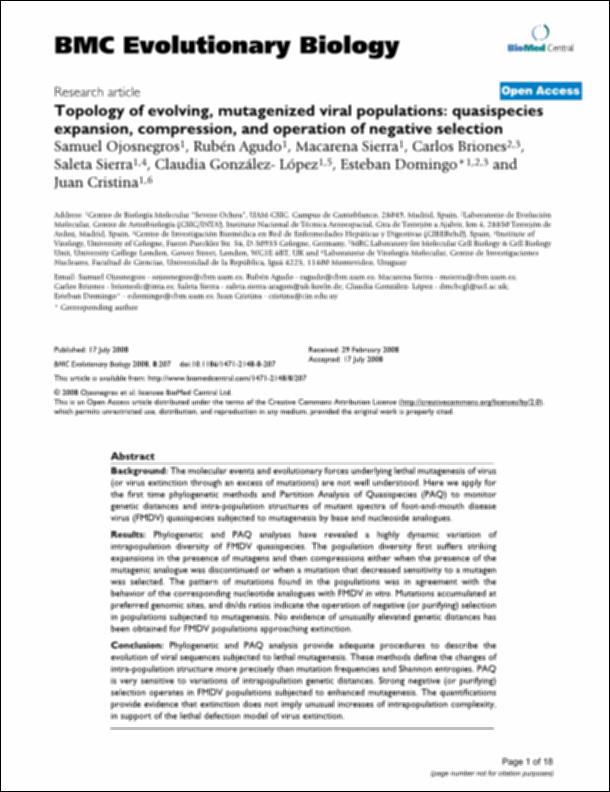Please use this identifier to cite or link to this item:
http://hdl.handle.net/10637/15654Topology of evolving, mutagenized viral populations: quasispecies expansion, compression, and operation of negative selection
| Title: | Topology of evolving, mutagenized viral populations: quasispecies expansion, compression, and operation of negative selection |
| Authors : | Ojosnegros, Samuel Agudo Torres, Rubén Sierra, Macarena Briones, Carlos Sierra, Saleta González-López, Claudia Domingo, Esteban Cristina, Juan |
| Keywords: | Partition Analysis of Quasispecies; Mutagenesis |
| Publisher: | BMC |
| Citation: | Topology of evolving, mutagenized viral populations: quasispecies expansion, compression, and operation of negative selection. Ojosnegros A, Agudo R, Sierra M, Briones C, Sierra S, González-López C, Esteban Domingo. BMC Evolutionary Biology 8 (1):207 (2008). |
| Abstract: | Background: The molecular events and evolutionary forces underlying lethal mutagenesis of virus (or virus extinction through an excess of mutations) are not well understood. Here we apply for the first time phylogenetic methods and Partition Analysis of Quasispecies (PAQ) to monitor genetic distances and intra-population structures of mutant spectra of foot-and-mouth disease virus (FMDV) quasispecies subjected to mutagenesis by base and nucleoside analogues. Results: Phylogenetic and PAQ analyses have revealed a highly dynamic variation of intrapopulation diversity of FMDV quasispecies. The population diversity first suffers striking expansions in the presence of mutagens and then compressions either when the presence of the mutagenic analogue was discontinued or when a mutation that decreased sensitivity to a mutagen was selected. The pattern of mutations found in the populations was in agreement with the behavior of the corresponding nucleotide analogues with FMDV in vitro. Mutations accumulated at preferred genomic sites, and dn/ds ratios indicate the operation of negative (or purifying) selection in populations subjected to mutagenesis. No evidence of unusually elevated genetic distances has been obtained for FMDV populations approaching extinction. Conclusion: Phylogenetic and PAQ analysis provide adequate procedures to describe the evolution of viral sequences subjected to lethal mutagenesis. These methods define the changes of intra-population structure more precisely than mutation frequencies and Shannon entropies. PAQ is very sensitive to variations of intrapopulation genetic distances. Strong negative (or purifying) selection operates in FMDV populations subjected to enhanced mutagenesis. The quantifications provide evidence that extinction does not imply unusual increases of intrapopulation complexity, in support of the lethal defection model of virus extinction. |
| URI: | http://hdl.handle.net/10637/15654 |
| Rights : | http://creativecommons.org/licenses/by-nc-nd/4.0/deed.es OpenAccess |
| ISSN: | 2730-7182 |
| Issue Date: | 17-Jul-2008 |
| Appears in Collections: | Facultad de Farmacia |
Items in DSpace are protected by copyright, with all rights reserved, unless otherwise indicated.


